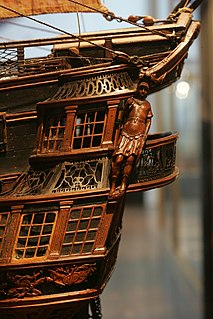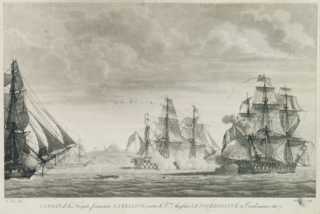
HMS Coventry was a 28-gun sixth-rate frigate of the Royal Navy, launched in 1757 and in active service as a privateer hunter during Seven Years' War, and as part of the British fleet in India during the Anglo-French War. After seventeen years' in British service she was captured by the French in 1783, off Ganjam in the Bay of Bengal. Thereafter she spent two years as part of the French Navy until January 1785 when she was removed from service at the port of Brest. She was broken up in 1786.
HMS Hannibal was a 50-gun fourth rate ship of the line of the Royal Navy, built by Adams of Bucklers Hard and launched on 26 December 1779. The French ship Héros captured Hannibal off Sumatra on 21 January 1782.

Artésien ('Artesian') was a 64-gun ship of the line of the French Navy, lead ship of her class. She was funded by a don des vaisseaux donation from the Estates of Artois.

Bellone was an Iphigénie-class 32-gun frigate of the French Navy on plans by Léon-Michel Guignace. She took part in the American Revolutionary War in the Indian Ocean with the squadron under Suffren, and later in the French Revolutionary Wars. She was present at the Glorious First of June.
The Illustre was a 74-gun Magnanime class ship of the line of the French Navy. She took part in the War of American Independence and in the French Revolutionary Wars. Damaged beyond repairs during the Expédition d'Irlande, she was scuttled on 30 December 1796.

Admiral comte Pierre André de Suffren de Saint Tropez, bailli de Suffren, Château de Saint-Cannat) was a French Navy officer and admiral. Beginning his career during the War of the Austrian Succession, he fought in the Seven Years' War, where he was taken prisoner at the Battle of Lagos. Promoted to captain in 1772, he was one of the aids of Admiral d'Estaing during the Naval battles of the American Revolutionary War, notably taking part in the Siege of Savannah.
Ajax was a 64-gun ship of the line of the French Navy.
Sévère was a 64-gun ship of the line of the French Navy.
Fine was a Sybille class 32-gun, copper-hulled, frigate of the French Navy.
Étienne-François de Cillart de Villeneuve was a French aristocrat and Navy officer, brother to Armand-François Cillart de Surville and Jean-Marie de Villeneuve Cillart.

Armand de Saint-Félix was a French Navy officer and admiral.
Louis-Hyacinte de Cavelier, chevalier de Cuverville was a French Navy officer.
Jean André de Pas de Beaulieu was a French Navy officer.
The action of 12 August 1782 was a minor single-ship action that opposed the French 32-gun frigate Bellone to the British 28-gun HMS Coventry in the run-up to the Battle of Trincomalee. Although both ships were frigates, Bellone belonged to the Iphigénie class and was a comparatively large frigate for her time, carrying a battery of 18-pounder long guns, while Coventry was a sixth-rate armed only with 9-pounder long guns. Furthermore, Bellone had the advantage of the wind. The nominal crew of Coventry was about tho thirds of that of Bellone, but in the occasion it was reinforced by the troops she was carrying. In spite of these overwhelming odds, Coventry managed to inflict heavy casualties on Bellone, and most decisively to shoot most of the senior staff. The resulting confusion on Bellone allowed Coventry to escape to Madras.
René Joseph Bouvet de Précourt was a French Navy officer. He was captain of the 64-gun Ajax in Suffren's squadron in the Indian Ocean during the War of American Independence, and fought at the Battle of Sadras on 17 February 1782.
Antoine Melchior Gaspard de Bernier de Pierrevert was a French Navy officer. He was nephew to Suffren and brother to Louis Jérôme Charles François de Bernier de Pierrevert.
Beaumont le Maître was a French Navy officer. He fought in the Indian Ocean under Suffren during the War of American Independence, notably captaining the 64-gun Ajax at the Battle of Trincomalee from 25 August to 3 September 1782 and Saint Michel at the Battle of Cuddalore on 20 June 1783.
Louis-Esprit d'Aymar was a French Navy officer. He fought in the Indian Ocean under Suffren during the War of American Independence, captaining the 64-gun Saint Michel at the Battle of Trincomalee from 25 August to 3 September 1782, and the 74-gun Annibal at the Battle of Cuddalore on 20 June 1783.
Félix d'Hesmivy de Moissac was a French Navy officer. He fought in the War of American Independence, earning a founding membership in the Society of the Cincinnati, and taking part in the French operations in the Indian Ocean as Suffren's flag captain.
Jean-Marie Kersauson de Goasmelquin was a French Navy officer. He fought in the War of American Independence, and took part in the French operations in the Indian Ocean under Suffren.





